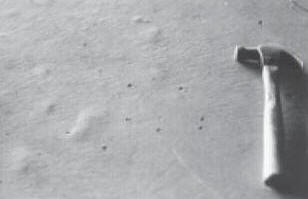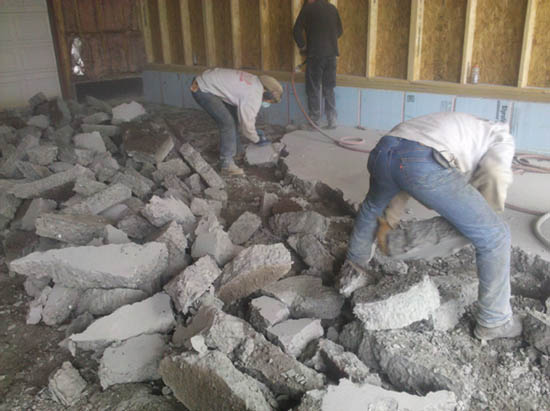Blistered Concrete Slab
Concrete Blisters
Last week was one of those weeks when it seemed everything went wrong on one of my commercial building projects. First we found out that our siding product was defective and then a slab we poured for a vehicle service bay had blistered concrete! Needless to say you can see the final verdict on the slab above as a very tired concrete crew ripped it out with jack hammers today.
Concrete Blister Causes


Needless to say this isn’t a very common issue with concrete so it’s worth talking about the causes of concrete blisters and how to avoid them. According to the National Ready Mix Association there are several causes of concrete blisters including:
- Blistering is usually the result of the top surface hardening before bleed water and entrapped air can rise to the surface and escape. This results in water and air being trapped below a thin dense troweled layer.
- Thick slabs can be prone to this as the surface sets long before the lower levels of the slab.
- Slabs poured on really cold sub-grades can have the same issue where the cold ground delays setting of the concrete closest to the ground.
- Air entrained concrete that is trowel finished is VERY susceptible to this phenomenon.
- Excessive or insufficient vibration can cause blistering.
What Happened To Our Slab
Obviously this is a very complicated situation and one that doesn’t seem to happen often. At first I was quite baffled so I called our concrete testing company that tests all the concrete we pour. At first they were not aware of any issues with the concrete. However, after reviewing the results they called me back today to tell me they found the problem. Apparently the concrete supplier sent concrete that was air entrained (this is typically only done for exterior concrete to protect it from freeze thaw damage). This is a HUGE mistake for a slab to be trowel finished.
Apparently there was a mix up and someone thought it was an exterior slab that would only get a broom finish. Unfortunately the damage was done and there’s little that can be done to repair concrete blisters. To make matters worse this slab was for a automotive service bay which will see lots and lots of traffic. Therefore the only real solution was tearing out the slab and starting all over again. I’m glad that wasn’t our mistake!!
Testing…Testing…Testing
Often times I have clients ask me why we test the concrete and comment on the price of testing. This is a perfect example of why we test concrete. Concrete is an extremely complicated chemical mixture that can quickly go bad. By testing each batch of concrete there is a good record to help determine and possible problems and also to help determine what caused a problem.
Lower Photo Credit: National Ready Mix Association
Recent Posts
Framing Stick Nailer vs Coil Nailer
Which is Better a Stick Nailer or Coil Nailer? Framers have many choices in nailers…
How Many Roofing Nails Per Square of Shingles
Estimating How Many Nails for a New Roof When it comes to estimating materials for…
Composite / PVC Decking – Layout Tips & Advice
Composite / PVC Decking Layout Tips and Advice Composite and PVC decking have really changed…
Benefits of an ERV System (Energy Recovery Ventilator)
Benefits of ERV Systems (Energy Recovery Ventilator) If you're building a new home or doing…
Vermiculite Attic Insulation Abatement
Vermiculite Attic Insulation If your home was built before 1990 there is a chance it…
Nuisance Tripping of AFCI (Arc Fault) Circuit Breakers
Arc Fault (AFCI) Circuit Breakers Tripping Often An arc-fault circuit interrupter (AFCI) or arc-fault detection…

View Comments
Wow, that's a major pain!
Who ends up paying for removing the concrete? The customer or the concrete company?
Concrete company!!! The slab would never perform.....sucks but it's the right thing to do.
We had a driveway poured last October....Halloween to be exact.
I thought it might be late in the season, but they assured me it was still possible.
We are having issues with blistering....near the garage. Everyday more little chunks pop up, exposing the gravel. What is causing this...why isn't it happening on the full length of the driveway, and what do we do?
I fear this driveway is going to be very porous and deteriorate.
What part of the Country do you live in? What type of finish did they use? trowel? brush?
The Driveway on the north side of a structure would be colder in winter months without the sun to warm the ground.The rest of the Driveway could have been in the Sun.
Where does one get concrete tested?
JP - In most areas you can hire a concrete testing company. Typically they are listed as a construction material testing company. If you call your local concrete supplier they can certainly point you in the right direction.
How did the contractor make that mistake in the first place?
They were pouring an interior slab and an exterior approach slab the same day. Exterior concrete needs air entrainment. Simple mistake....very costly.
I think what Judy Sokolow describes is spalling where the thin troweled layer on top deteriorates and exposes aggregate. There are several causes for spalling. Hard to determine why without more info. October is fine to pour in most parts of the country.
I don't see any rebar or mesh. Is that normal?
Depends on the project. Plenty of thick slabs get poured without reinforcing bars when it has a good sub-grade. This slab had fibers in it.